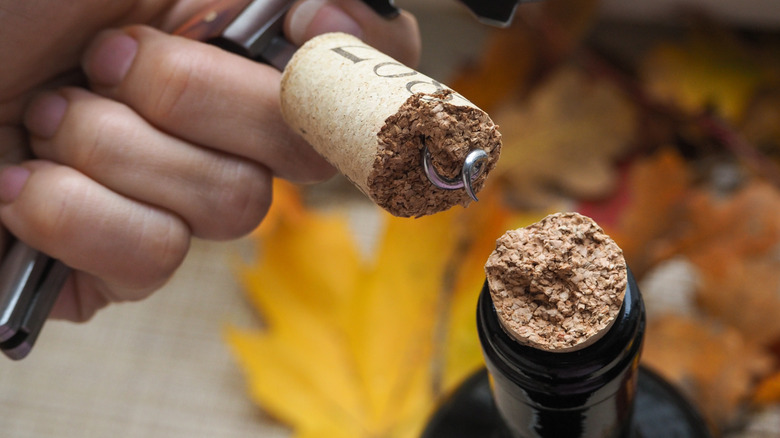How To Power Through The Tragedy When A Wine Cork Breaks
Whether a broken cork is the result of haste while enthusiastically trying to pop open that bottle after a long week of work, or it can be blamed on the cork itself, it's a problem that needs an immediate solution — especially if you're not the only one in the room when it happens. So what do you do to save face — and, even more importantly, the wine — when you're left with a wine key that's holding only half a cork?
While the situation may seem daunting at the time, there are a few ways to fix it outside of just pushing the remainder of the cork into the bottle (though that is a viable option with a tool or two that will preserve the wine or make it easier to pour). You can still use your corkscrew to craftily retrieve the cork, employ another tool beloved by sommeliers — the butler's thief — or even put water to work to help open up that bottle and rescue its grapey goodness (and your reputation).
Techniques and tools for retrieving the cork
It's certainly a possibility that if you attempt to continue to use the corkscrew, you could push the cork straight into the bottle rather than retrieve it. However, if you're patient and careful, you can reap the rewards of obtaining access to your wine — and potentially impress guests in the meantime.
Master Sommelier June Rodil told Food & Wine that broken corks aren't uncommon, even for sommeliers. Her trick is to move the wine opener over so that it's against the inside of the neck of the bottle. She said, "I move the screw to the very side of the cork and twist it in at an angle toward the edge of the bottle. If you go through the center, the broken part is more likely to go down into the bottle."
Another tried and true method is using a tool called the butler's thief. This two-pronged tool is designed so that each prong can slide down the side of the inside of the bottle, between the bottle's neck and the cork. Then, you can gently twist and remove the cork from the bottle.
Other options to save your wine
If the cork is still resistant to removal from the bottle, it's possible that simply using your faucet will help you to fish it out. Hold the neck of the bottle under hot running water and let science work its magic. In less than a minute, the glass may expand enough to allow you to easily remove the cork.
Of course, all of these options run the risk of driving the cork into the wine bottle, rather than out of it. However, all is not lost if that's the case — a broken cork that comes in contact with the wine will not damage the wine or make it "corked."
"Cork taint is not a product of cork itself; it happens due to the presence of a chemical compound (TCA), which can occur in any cork, old or new, dry or moist. If it isn't there to begin with, then it won't be there when the cork breaks," Master Sommelier Clement Robert told Decanter.
If the cork does sink into the bottle, there are two paths to take that lead to finally being able to relax with a glass of your vino. First, you can simply use the handle of a utensil (like a spoon) to hold back the cork while pouring. Alternatively, find a clean container like a pitcher or decanter, and pour the wine into it through a clean cheesecloth or coffee filter to ensure that all of your wine is free from cork debris.



